Learn why Posture and Muscle Balance are Interrelated and EXTREMELY Important for Health & Performance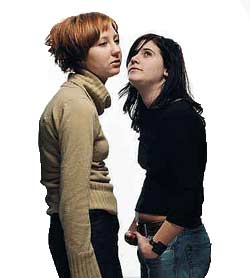 You Need to Know about 2 Types of Posture You Need to Know about 2 Types of PostureStatic Posture When someone mentions posture you probably immediately think of static posture. Static posture is the alignment of your body while you are still. More importantly static posture refers to the length-tension relationships of your muscles and the corresponding alignment of your joints. You may first notice posture problems when someone or yourself observes your static posture. Dynamic Posture The length-tension relationships between working and opposing muscles are especially important to dynamic posture. Dynamic posture is the alignment of your body during movement. Poor dynamic posture can influence static posture and vice versa. Since many exercises are repetitive movements, it is important to keep your dynamic posture in mind. Posture Problems you may Not Know about can Lead to InjuryIf you have imbalanced length-tension relationships and improper dynamic posture during movement, the constant tug of war between muscles can prematurely age your joints and possibly lead to muscle, joint, tendon and ligament injuries. These groups of muscle imbalances are called postural distortion patterns. There are many problems associated with poor posture which have negative long term effects on your body and health. These problems with your posture will not only impact how you feel but how your body looks. If you continue to exercise with poor posture you will recruit the wrong muscles and build your body disproportionately. Physical therapists are devoted to fixing problems after injuries happen, some due to posture problems. Orthopedic surgeons physically repair any musculoskeletal overuse or traumatic injuries, some which are due to posture problems. Personal Trainers take a Preventative and Corrective Stance to fix your Posture Problems Before they Lead to Injury
What causes the Common Posture Problems ?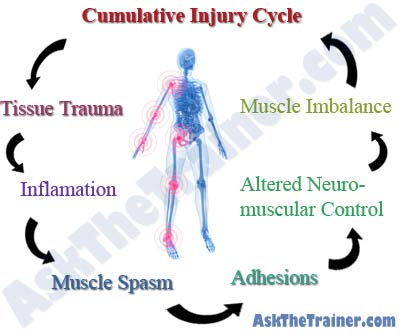 Muscle Imbalances due to our Sedentary Lifestyle are A Primary Cause The cumulative injury cycle illustrates how muscle imbalances originate. There is a trauma, which can result from repetitive motion with poor dynamic posture, or poor static posture. The trauma causes inflammation which causes your muscles to spasm and develop knots or adhesions. The adhesions decrease the functionality of your muscles which your brain cannot control properly. The inability of your nervous system to maintain proper postural alignment causes muscle imbalances. If you do not correct your muscular imbalances the cycle will repeat over and over again and get progressively worse. If You ask Professionals from Different Fields you may get Different AnswersA chiropractor may tell you that your spine is out of alignment and that causes posture problems. A podiatrist (foot doctor) may tell you your whole body is out ob alignment because of a bad fitting pair of shoes or flat feet. A psychologist may even tell you that your bad posture is due to depression. The point is, there are many different ways to look at posture problems and there may be many ways to solve them. You don’t have to be a personal trainer, doctor or specialist who deals with the human body to see that muscle imbalance is a likely cause of posture problems.
What are some Common, Specific Muscle Imbalances ?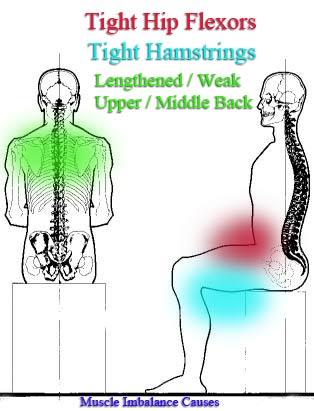 The most common muscle imbalances are due to our sedentary lifestyle. When you are seated for a large percentage of time, you can see which muscles are tight or shortened. If a muscle is shortened for a prolonged period if time, it will become tight which really means it will become shorter than it is meant to be. When a muscle is shorter than the optimal length, it not only effects the opposing muscle but can have repercussions on the entire musculoskeletal system. Here are some common muscles which cause the most posture problems.  Tight Hip Flexors Tight Hip FlexorsTight Hip Flexors are a major cause of many posture problems. The human body is meant to be upright. When it is subjected to long hours of being seated the hip flexors become shortened. When the hip flexors are shortened they cause the pelvis to rotate anteriorly. You can see the repercussions of anterior pelvic tilt on skeletal alignment. The lumbar spine becomes excessively arched and the thoracic spine develops a kyphotic (rounded/hunch back) alignment. Forward head posture can result because of this as well. Tight hip flexors can begin to do the abdominals work, and make it almost impossible to get benefit out of some abdominal exercises. Tight hip flexors causes the primary hip extensors the gluteus maximus to become lengthened and weak. This is because of the agonist-antagonist relationship which means the glutes and hip flexors are opposing muscles. When the primary hip extensors become weak the synergist (helper) muscle takes over causing further problems. Tight HamstringsYou can probably feel the difference in length of your hamstrings when you sit down. When you stand, the muscles are lengthened. Sitting even in good posture (above) shortens your hamstrings. If you sit for prolonged periods of time, you will be prone to chronic hamstring tightness. There are a few posture problems associated with tight hamstrings. If the hip flexors (above) are tight, the hamstrings will become your primary hip extensor. The hamstrings are supposed to be the synergist but become the prime mover. This is called synergistic dominance which increases the chances of injury. It is easy to see why synergistic dominance increases the chances of injury. The gluteus maximus the largest muscle in the body. If the gluteus maximus cannot extend the hip, the hamstrings which are not as powerful as the glutes are forced to do more work than they are designed for. If you have tight hamstrings you will find it difficult to work and get results with your legs and butt exercises. Hamstrings tightness can also make you prone to hamstrings strains, pulls, and sciatica. Weak & Lengthened Upper Middle Back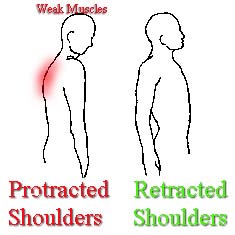 Forward shoulders is another muscle imbalance which causes posture problems which are repercussions of the sedentary lifestyle. Also called the upper cross syndrome, forward shoulder posture is prevalent you are inactive and especially if you have a job sitting at a desk in front of a computer. Forward shoulders is another muscle imbalance which causes posture problems which are repercussions of the sedentary lifestyle. Also called the upper cross syndrome, forward shoulder posture is prevalent you are inactive and especially if you have a job sitting at a desk in front of a computer.
You can also develop forward shoulders posture from poor exercise selection. If you perform too many push exercises (bench press, shoulder press, push-ups) and either neglect your back exercises, or perform improperly, you can develop this muscle imbalance. The primary muscles responsible for shoulder retraction in the middle upper back (lower and middle trapezius and rhomboids) are lengthened and weak. The primary muscles in the font (pecs and anterior deltoids) which oppose shoulder retraction are tight. This is why people who perform too many pushing exercises in relationship to pulling exercises tend to develop these posture problems. If you have any degree of forward shoulders posture it is very important to maintain shoulder retraction for the duration of your weight training exercises. Any of these muscle imbalances and the associated posture problems will prevent you from optimally using the targeted muscles during all exercises. If you suffer from this muscle imbalance and are not able to retract your shoulders, which is common in many people, you should start a corrective flexibility program.
Are there some Muscle Imbalances which Are More Prevalent in Men than Women ?Many muscle imbalances develop because of common daily postures. Since men and women have different mannerisms certain posture problems are more common in one sex but still occur in both. Here are 3 More Common Muscle Imbalances and Associated Posture Problems Which Primarily occur in Either Sex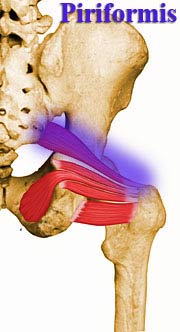
Tight PiriformisThe piriformis is a deep muscle which is the most powerful external rotator of the hip. A tight piriformis is more common in men than women because men tend to sit with their legs spread apart for obvious reasons. A tight piriformis can lead to problems with the knees and also piriformis syndrome. Piriformis syndrome is is when the piriformis irritates the sciatic nerve and causes a deep shooting pain from the buttocks down the back of the leg. This is commonly referred to as sciatica. Tight AdductorsSince women most often sit with crossed legs the adductor muscles commonly develop tightness especially in the bottom of a squat in which the hips are almost fully flexed. The adductor complex is a the group of muscles which squeeze your legs together. Tight adductors can cause the femur (upper leg bone) to become internally rotated. This in combination with the following imbalance will most likely lead to kneecap pain because the joints of the knee will no longer line up properly. Tight adductors can be demonstrated by a knock kneed appearance. Tight CalvesWomen who wear high heels often are very prone to tight lower leg muscles including the gastrocnemius, soleus, and peroneals. The tightness in these muscles can be demonstrated by flattened and externally rotated feet. Tight calves can also be a leading cause in plantar fasciitis which is extremely painful.
How can You Prevent and Correct Posture Problems due to Muscle Imbalance ?The Most Important Step of Prevention is Detection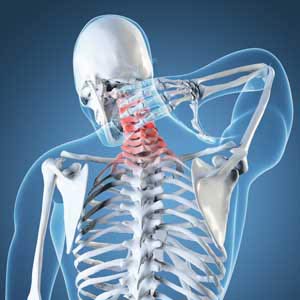 It may be obvious to you if you have pronounced posture problem. If it is not obvious, it is a good idea to see a specialist such as a personal trainer, chiropractor or exercise physiologist. There are a few tests in a which a professional can use to diagnose specific posture problems. There are telltale signs which a professional such as a personal trainer recognizes during functional movements that show your posture problems. You may be able if your observe your own movement in a mirror. Once know which of your muscles needs to be strengthened or loosened up you can move on to the next step. Get to the Core of the ProblemYou can not get a strong core sitting at a desk all day. The muscles which are closest to your body’s center of gravity have to be strong for a fully efficient workout. If you perform the best core exercises properly you will teach your body to maintain proper dynamic postural alignment for the duration of all your exercises. You will also improve your static posture. Since the hip flexors and glutes are at the core of the lumbo-pelvic hip complex you should have the proper length-tension relationship between them. Since hip flexors are usually tight and glutes are weak, you need to strengthen your glutes. The very best way to strengthen your glutes is most multi-joint leg exercises. You just have to be aware that you contract the correct muscle. Corrective Flexibility can Help you Restore Your Body’s Balance If you have muscles which are chronically tight, corrective flexibility takes a direct approach. Muscles which are tight due to chronic posture such as sitting all day at a desk take time to correct. Just like weight loss, what happens over weeks, months and even years, is not easily reversible. Once you know your correctable, structural posture problems you can follow a corrective flexibility program. Each corrective flexibility exercise should be specific to your situation. Since this takes time, you should perform these corrective flexibility exercises daily if possible.
What are Some Corrective Flexibility Exercises to combat Muscle Imbalance and Posture Problems ?It is Best to Use Multiple Types of Flexibility Training!Rather than going into a long, boring scientific explanation which you could care less about, here are 2 different ways which you begin to correct your muscle imbalances and posture problems. Self-Myofascial Release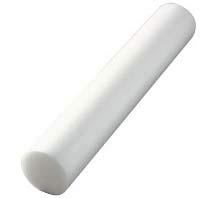 Self-myofascial release (SMFR) sounds a lot more complicated than it is. Myo- is the prefix meaning muscle. Fascia is the tissue which surrounds your muscles. Repeated muscular contraction can cause you to develop adhesions or spots of muscle tension. You will be releasing the tension of your muscles by your self. Self-myofascial release (SMFR) sounds a lot more complicated than it is. Myo- is the prefix meaning muscle. Fascia is the tissue which surrounds your muscles. Repeated muscular contraction can cause you to develop adhesions or spots of muscle tension. You will be releasing the tension of your muscles by your self.
Self-myofascial release is basically a form of massage. You can get myo-fascial release from a massage therapist at $70 an Hour or you can do it yourself. The best way to perform self-myofascial release is with a foam roller (left), massage ball, medicine ball or even a hard ball. Place the tight body part on the foam roller. The most important thing to remember is to always relax the muscle which you are applying pressure to. Apply pressure to the entire length of the muscle with the foam roller. Even though it is just a piece of foam, as you move up and down the muscle you will notice some spots hurt very bad. The muscles have hypertonicity which you can think of as tension. Apply pressure to the most tender spots for 20-30 seconds each. Self-myofascial release is not for everyone. You may feel like it does nothing for you. If you feel this way, make sure you do it 100% correctly before you abandon it. Each progressive time you SMFR a muscle, you will notice less tension and the tender spots will go away over time. It takes longer for some muscles than others. You can perform SMFR before or after a workout. You should focus your SMFR on the muscles which are the root of your muscle imbalances and posture problems. Make sure you perform each session on the foam roll before your static stretching. Static StretchingStatic stretching is the classic stretching technique you learned from your high school P.E. teacher. You can help to correct posture problems most efficiently with a combination of SMFR and static stretching. Static stretching is rather simple. Hold your body in the position of “slight discomfort” for at least 20 seconds. There are some tips and pointers to help you get the most benefit from your stretching program. - Leg Stretches
Find videos and descriptions of different flexibility and stretching techniques for your legs. Static stretches as well as dynamic and SMFR techniques are covered as well. - Upper Body Stretches
Find videos and descriptions of flexibility techniques and stretches for your upper body, arms and neck. Learn about dynamic, static, active as well as SMFR stretching techniques for your upper body.
Must Reads if you wish to Avoid Posture Problems from Muscle Imbalances- Hunchback Posture Problems
Many people’s poor posture causes them to resemble a hunch back which is most likely just another posture problem caused by muscle imbalances. - Best Core Exercises to Prevent Postural Imbalance
Start your exercise program off the optimal way. The best way to deal with posture problems is to prevent them from happening in the first place. Each core exercise may seem simple, but there are many things you must do correctly to get the most benefit. - Learn how Personal Trainers can help you Correct Muscle Imbalances
Find about how personal trainers can help you as a client and how you could be helping people’s posture problems as a personal trainer. Learn why the philosophy used by the National Academy of Sports Medicine is the best for most people. Posture problems are a thing of the past if you follow the OPT Optimal Performance Training Model. Prevent and stop muscle imbalance.
 该贴已经同步到 jacky的微博 该贴已经同步到 jacky的微博 |  发表于 2012-6-18 03:20:38
发表于 2012-6-18 03:20:38
 |小黑屋|手机版Mobile|体能论坛
( 粤ICP备15092216号-2 )
|小黑屋|手机版Mobile|体能论坛
( 粤ICP备15092216号-2 )